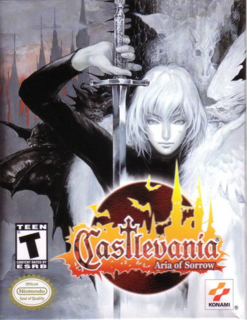Aria of Sorrow is a joyful tune.
Aria of sorrow breaks a little new ground by being set in Japan in the near future. While that may leave some wondering what happened to the gothic European setting of every other game, rest assured that nothing really has changed. The game still takes place in Dracula's castle, and everything still looks pretty much the same, though Dracula seems to remodel his castle with each incarnation.
The story focuses on an exchange student named Soma Cruz, who is whisked away to Dracula's castle during an eclipse. Lost and confused, Soma begins to realize that he possesses some dark powers, namely the ability to steal the souls of monsters he vanquishes. Along the way, he runs into others who have found their way into the castle, and the story unfolds in little scenes that contain awkward poorly-written dialogue. So, while the story isn't perfect, at least Konami gets points for effort.
But, the recent incarnations of Castlevania haven't been about story, they've been about exploration. Since Symphony of the Night on the PSX, Castlevania has taken on a Metroid-like quality, and Aria doesn't stray from this model. As before, the main character slowly acquires new abilities that allow him to get past previously insurmountable obstacles. This, of course, requires a fair amount of backtracking, which can get a bit old. Warp points are built along the way to make long travels less cumbersome, and the new feature of being able to select your warp spot before transporting really speeds the process up.
Like Symphony of the Night, Aria of Sorrow allows the main character to utilize a ton of different weapons, from swords to firearms. Amazingly, each weapon has a unique animation that takes into account the weight and size of the weapon. But, it's not just window dressing: each weapon handles differently, and you must take into account the rate, range, and power of each weapon. While this offers up a tremendous amount of variety, you'll probably find that you're more comfortable with a few weapons, and the remainder will go unused.
Speaking of variety, there is also a lot of variety in the game's subweapons. Gone are the cross, holy book, and the axe (gasp!). Instead, the standard Castlevania subweapon system is replaced by the soul stealing scheme. Every so often, after vanquishing an enemy, Soma will absorb their abilities, which can be equipped as subweapons. The list is quite extensive, but includes abilities like tying people up in webs, throwing grenades, and even chucking hot curry at enemies. While the variety is amazing, again, most of the abilities go unused, and truth be told, I miss my holy water and dagger.
Overall, the gameplay in Aria of Sorrow, while good, is not as good as previous games in the series. The castle layout is not as interesting as in previous games, nor does the game seem to flow as well. While the automap helps with exploration of the castle, the map's new depiction of exits makes it more difficult to read. The enemies in the game are not as creative or impressive as those in Harmony of Dissonance (even though many of those were recycled from SOTN), and they seem to lack variety in the way they attack. All in all, Aria just seems less creative than previous entries in the game.
Aria's graphics are at the same time better and worse than the graphics in the amazing Harmony of Dissonance. Overall, the graphics have been designed to look "cleaner", with clear outlines, and simple textures. While some may like this look, it makes the game look more cartoony than Harmony. The backgrounds in Aria are very impressive, with a lot of activity in the backgrounds, as well as multiple layers of parallax which really convey a sense of the huge scale of Dracula's castle. However' the foregrounds are a lot less impressive than in Harmony. They lack the detail and variety of Harmony, and generally look oversimplified and washed-out. Aria's characters animate more smoothly than in previous games, but, like the environments, they are drawn more simply than in previous games.
The sound quality has been improved for Aria, which will come as a relief to those who didn't like HOD's tinny sound. Unfortunately, a lot of the great Castlevania tunes are absent, replaced by a largely forgettable soundtrack. While Harmony was tinny, at least the tracks were memorable.
All in all, Aria of Sorrow is a great game, and a must-have for fans of the series. While it's a bit better and more balanced than the previous two entries in the challenge department, the game just doesn't feel as expansive or as polished as Harmony of Dissonance. If you've played Harmony of Dissonance, Aria will be a refreshing change of pace, but if you're new to the GBA Castlevania games and only have time and money for one of them, Harmony of Dissonance is a better choice to inagurate you into the fold.

